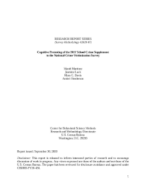Cognitive Pretesting of the 2017 School Crime Supplement to the National Crime Victimization Survey
Cognitive Pretesting of the 2017 School Crime Supplement to the National Crime Victimization Survey
Abstract
At the request of the National Center for Education Statistics (NCES) and the Bureau of Justice Statistics (BJS), the Center for Behavioral Science Methods (CBSM) conducted cognitive testing of the School Crime Supplement (SCS) to the National Crime Victimization Survey (NCVS). The supplement is used to collect data on students’ perspectives on school climate including a variety of topics such as the availability of drugs and alcohol, fighting, bullying, and hate related behaviors, and students’ perception of how safe they feel in their school. The cognitive testing discussed in this report focused on the section of questions about being bullied in schools. The purpose of this cognitive research was to test new and revised questions for the 2017 School Crime Supplement to the NCVS. This report presents the findings from the 30 cognitive interviews that CBSM conducted between May 2016 and July 2016.
The findings from this study indicate that the questions in the bullying section for the SCS generally performed well. Questions measure various characteristics of bullying experiences, including – but not limited to -- the prevalence of bullying behaviors against the student, the frequency of being bullied, likelihood of repetition, and a power imbalance between the victim and perpetrator. Most questions were easy for interviewers to administer, and easy for respondents to understand and answer. These questions required no revisions. Of those questions that required revisions, some were minor modifications. For the repetition question, an ambiguous phrase was replaced with a clear one to reduce the likelihood of measurement error due to varying interpretations by respondents. A second question with a minor revision was modified to include an additional response option.
The question about a power imbalance was of particular interest. Students’ responses to probes indicated that the question would benefit from a new item measuring another dimension of power the original item did not ask about: the ability to influence what other students think of them. Another question of interest was the question measuring the frequency of the bullying, as it is also used to establish repetition. Ultimately, the decision was made to use a new version of the question asked how many days the bullying incidents occurred. A follow up question was added to determine if students who reported experiencing bullying behaviors on only one day experienced multiple repeated behaviors throughout that single day.
Others in Series
Working Paper
Working Paper
Working Paper




